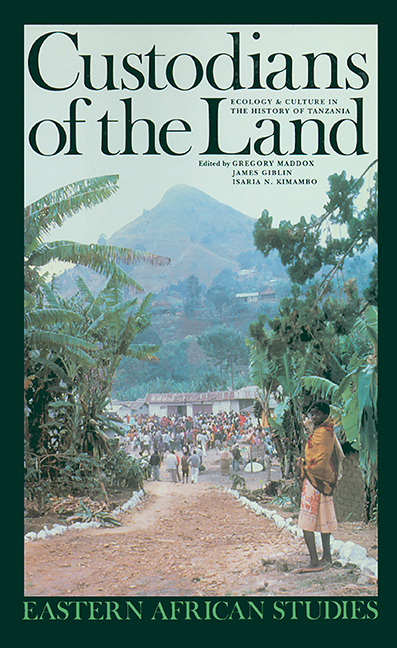Book contents
- Frontmatter
- Contents
- List of Maps, Figures & Tables
- List of Photographs
- Abbreviations
- Contributors
- Acknowledgements
- Introduction Custodians of the Land: Ecology & Culture in the History of Tanzania
- Part One Environmental & Demographic Change
- One Population: A Dependent Variable
- Two Environment & Population Growth: In Ugogo, Central Tanzania
- Part Two Environmental Change & Economic History: In Tanzania's Northern Highlands
- Part Three Politics & Environmental Change
- Part Four Environment & Morality
- Conclusion
- Bibliography
- Index
Two - Environment & Population Growth: In Ugogo, Central Tanzania
from Part One - Environmental & Demographic Change
Published online by Cambridge University Press: 30 August 2017
- Frontmatter
- Contents
- List of Maps, Figures & Tables
- List of Photographs
- Abbreviations
- Contributors
- Acknowledgements
- Introduction Custodians of the Land: Ecology & Culture in the History of Tanzania
- Part One Environmental & Demographic Change
- One Population: A Dependent Variable
- Two Environment & Population Growth: In Ugogo, Central Tanzania
- Part Two Environmental Change & Economic History: In Tanzania's Northern Highlands
- Part Three Politics & Environmental Change
- Part Four Environment & Morality
- Conclusion
- Bibliography
- Index
Summary
Ugogo, in central Tanzania, has throughout the twentieth century been regarded as the most famine-prone region of the country. Today, Ugogo, the land of the Gogo people, covers most of Dodoma and Mpwapwa Districts in Dodoma Region and Manyoni District in Singida Region. It occupies the southern portion of the central plateau of Tanzania from the Rift Valley in the west to the Ruhebo Mountains in the east and from the northern border of Dodoma District south to the Ruha River. Generally it lies about 1000 metres above sea level and rainfall averages about 500 millimetres a year, right on the borderline that will support agriculture. Adaptation for survival, which stresses agropastoralism and social and geographic mobility in the face of the variability of agricultural production in this environment, defines the Gogo people more than anything else.
Over the course of the late nineteenth and the twentieth centuries famine struck the region repeatedly. The people of the region remember by name numerous famines and food shortages. From the Mtunya ('The Scramble’) of 1916-20 to the Nzala ya Merika ('Famine of America', referring to relief grain from America) of 1961, from the Sabatele (named after a measure of grain given as relief) of 1905 to the MauMau (which occurred concurrently with the uprising in Kenya, although it involved an outbreak of violence in Ugogo also) of 1954, drought, war, disease and infestation all struck the region. Yet during the British colonial era, from 1916 to 1961, population in the region and the number of people called ‘Gogo’ by the colonial government grew quite substantially (see Table 2.1). However, a closer examination of this population growth reveals that population did not grow uniformly during the British colonial era, but instead grew most rapidly between 1920 and 1930 and after 1955. In between, and especially in the period between 1942 and 1954, famine acted as a demographic brake on population growth.
The two periods of population growth mark changes in the demographic regime that accompanied changes in the relations between local communities and the broader colonial world. In turn, these changes reflect both changes in the social organization of production and the interaction between local communities and their environment. Population growth between 1920 and 1930 occurred as local communities absorbed immigrants and returning refugees after the depopulation of the preceding four decades.
- Type
- Chapter
- Information
- Custodians of the LandEcology and Culture in the History of Tanzania, pp. 43 - 66Publisher: Boydell & BrewerPrint publication year: 1996

